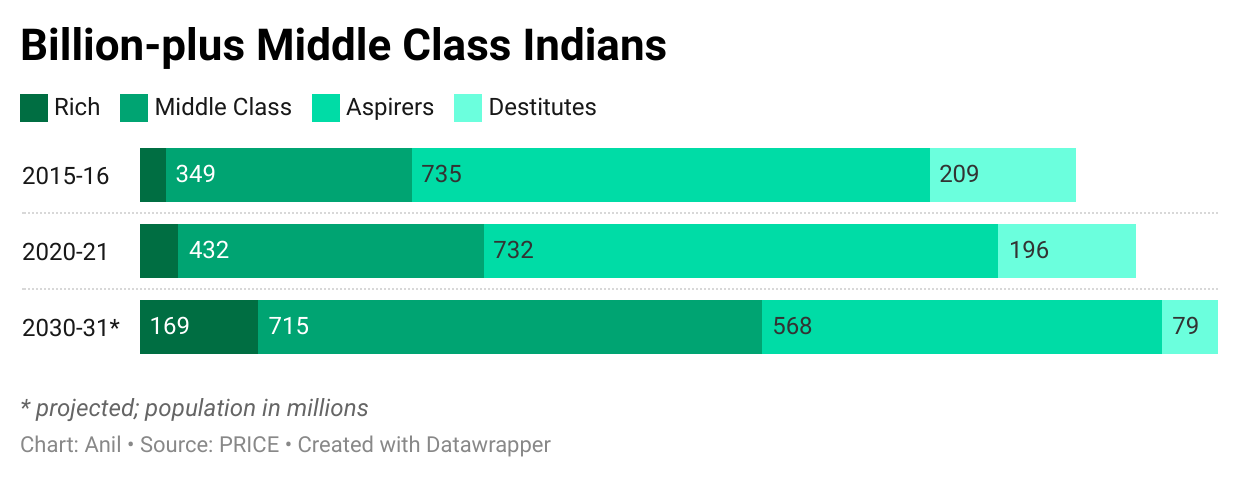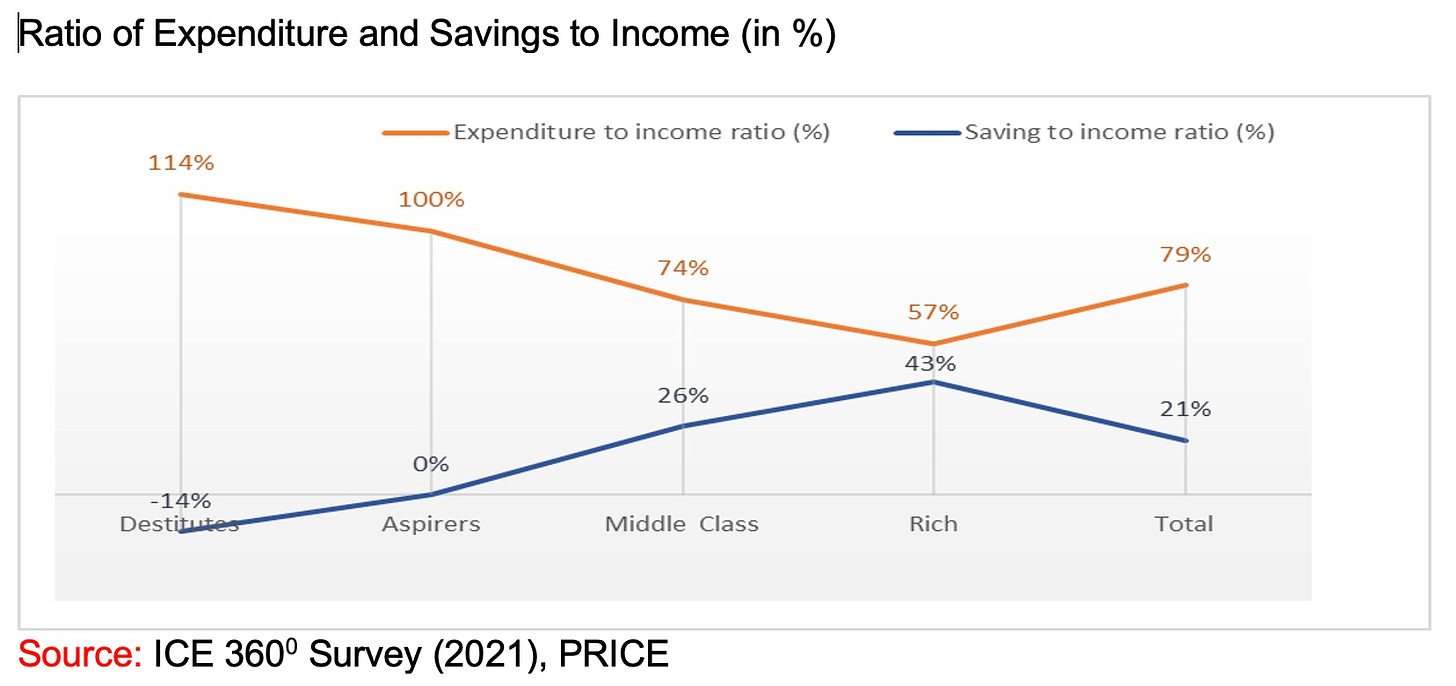INDIA'S TECHADE
A home-grown tech stack, favourable demographics and an ongoing geopolitical reset is poised to make this India's decade says Morgan Stanley. EPISODE #98
Dear Reader,
A very Happy Monday to you.
Last week two independent research efforts—one by Morgan Stanley, the global financial services, and another by PRICE, a domestic consumer research firm—served up good news about the Indian economy. Or rather about its future.
While Morgan Stanley argued that the next decade will be India’s as it rides the home grown digital tech stack to become the third largest economy in the world, PRICE claimed that in this period the middle class would grow dramatically, the number of poor would shrink, lending unprecedented momentum to the Indian economy.
The absolute claims of both projections may or may not hold up. However, the trajectory of change is spot on.
So this week I put the spotlight on what is clearly the ‘best is yet to come’ story about India. Given the central role of the home-grown tech stack, I dubbed it as ‘India’s Techade’. Do read and share your feedback.
The cover picture this week, taken by Pradeep Padmanabhan, captures the power of the home grown digital tech stack—alluded to by Morgan Stanley—that democratised identity, payments and in the process empowered those at the bottom of the pyramid—such that a street-side cobbler can be paid digitally for small sums; in fact nearly three-quarters of the average 7 billion monthly transactions using UPI are for less than Rs200.
A big shoutout to Balesh, Gautam, Rajiv, Premasundaran, Aashish, Vandana and Niranjan for your informed responses, kind appreciation and amplification of last week’s column. Gratitude also to all those who responded on Twitter and Linkedin. Reader participation and amplification is key to growing this newsletter community. And, many thanks to readers who hit the like button😊.
THE ELEPHANT’S WALTZ
Unmindful of all the doom scrolling in mainstream media, Morgan Stanley last week put out a report on India, that was not merely optimistic. It was a hosanna. Their outlier claim is that the next decade is India’s for the taking.
“The four global trends of Demographics, Digitalization, Decarbonization and Deglobalization are favouring the New India.
We estimate The New India will drive a fifth of global growth through the end of this decade.”
Wow!
Separately, a survey conducted by People’s Research on India’s Consumer Economy and Citizen Environment (PRICE), released last week, claimed that in this period the country’s middle class will balloon from the present level of 432 million to 715 million by 2030-31—an increase of 65.5%.
Seems logical given that the United Nations Development Fund (UNDP) just disclosed that India lifted a staggering 415 million people out of poverty, suggesting a key cohort of the country’s populace is trading up.
Connect the dots and the picture of emerging India is not just one which is flattering. Instead its significance lies in the fact that it is one which is immensely transformational. A makeover of this scale has been witnessed only once before with respect to China.
Needless to say this will force an unprecedented socio-economic transformation of India, resolving a bulk of its legacy problems and acquiring new and unfamiliar warts as it wades into uncharted territory. At the least it will trigger a reset in the country’s polity, some of which is already visible.
Up, Up and Away
Like I pointed out in the introduction, Morgan Stanley believes the next decade, based on the strong foundations that have been put in place in the last 10-15 years, will witness an explosion in India’s growth.
As the graphic above shows, India’s gross domestic product in nominal terms will grow from its present level of $3.3 trillion to $7.7 billion. This is a staggering growth projection. India will grow its economy by about $4.5 trillion in this decade—which is more than how much it grew in its first 75 years.
Morgan Stanley’s optimism about India is premised on three beliefs:
Offshoring: The ongoing geopolitical reset entailing decoupling of the West with China has opened up the possibility of India emerging as the factory of the world. This trend has got a leg up with the recent round of reforms, including record reduction in corporate tax rates, and the Production Linked Incentive (PLI) scheme.
Digital Differentiation: The digitalisation of the Indian economy is being powered by a unique home grown India tech stack. It is reinventing the way India consumes, lends and trades at scale. As a regular reader of this newsletter you would recall that this is a recurring theme here.
Energy Transition: The way India sources energy and consumes it is happening simultaneously. In short the increase in consumption will be powered by green energy, implying that legacy fossil-based power capacity need not be destroyed. It will also reduce India’s dependence on imported energy.
And for those of us who rightly worry about per capita income, Morgan Stanley has news. It will grow from its present level of $2,393 to $5,140 in 2031.
According to the financial services company, this will trigger a boom in discretionary consumption and a surge in stock market capitalisation to $10 trillion.
The Middle Class Rises
Implicit in this bright future of India projected by Morgan Stanley is one key variable: the middle class.
This cohort is driven by aspirations, spends, saves, invests and is very aware of its political rights. As a result, the middle class, even though they are not homogenous, have always been viewed as a key economic agent in the transformation of an economy.
Way back in 2007—when there was similar optimism about India—McKinsey Global Institute had zeroed in on the emerging middle class to argue that they would power the country’s consumer economy. But, India only flattered to disappoint.
However, the aspiration quotient of the Indian middle class kept growing. A nation-wide survey conducted by Carnegie Endowment, a US-based think tank, found that one in two people self-identified themselves as middle class even though their material conditions did not warrant it.
“We find that almost half of all respondents we surveyed across India identified themselves as part of the middle class. While there is substantial variation across states, which is not altogether surprising, identification is stronger in urban areas when compared to rural ones.
However, middle class identification is broad-based, spanning all income groups and educational strata. While there is an almost linear correspondence between income/education and middle class affinity, what is striking is not necessarily the difference between groups but the consistency across them.
When it comes to social aspiration and economic optimism, there is a distinct middle class positivity on both counts.
Statistical analyses suggest that middle class self-identification accounts for a good deal of the variation in economic optimism and social aspiration that is not attributable to either income or education.”
The recent research published by the United Nations Development Programme (UNDP) about India lifting a record 415 million out of poverty in 16 years ended 2021 only suggests that the country’s middle would have grown.
According to the study published by PRICE, the middle class (the segment which earns an annual income of Rs5-30 lakh) is 432 million in 2020-21—it was 349 million in 2015-16.
This cohort is projected by PRICE to top 1 billion by 2047, creating an unprecedented bulge in the middle demography.
And the economic significance of this expansion in the middle segment is reflected in the graphic below shared by PRICE.
While the aspirer class (annual income of Rs1.25-5 lakh) saves little or nothing, those at the bottom of the pyramid are in a debt trap.
However, the middle class clearly enjoys surplus income, which it saves/invests.
Proxy data like the one on demat accounts—tripling in the last three years to 100 million—surge in consumption of FMCGs, big burst in domestic and international travel, suggest that the middle class is growing rapidly and powering the consumer economy.
At the moment their aspirations exceed their earnings. But, as the Morgan Stanley report suggests that it is only a matter of time before aspirations catch up as the economy swings into a new growth path.
In the final analysis it is clear that India’s future is bright. This is welcome news for 1.3 billion Indians, who have spent most of the last 75 years looking in from the outside. Their participation in the Indian economy will not only mean inclusion, but will also lend unprecedented vitality and dynamism.
Needless to say, India’s rise augurs well for the world too.
Recommended Viewing
Sharing the latest post of Capital Calculus on StratNews Global.
This time it was a conversation with the brilliant Bibek Debroy. He is gifted with this incredible ability to break down a geeky subject in lay person terms.
Bibek, very candidly at that, walks us through the state of the economy—the good, bad and the ugly. He honestly admits that this phase of (imported) inflation has to be endured and that at current levels it is “not alarming” (Can’t say that about our neighbourhood, with Sri Lanka’s retail inflation topping a staggering 70%).
On the upcoming Budget he listed his priorities:
“My main expectation from the budget would be one, to state very clearly about continuity on the medium term trajectory of the fiscal consolidation.”
Hope these teasers draw you into watching the full interview. Favourable feedback shared by viewers on YouTube back my claims.
Sharing the link below:
Hope you liked the interview as much I enjoyed doing it. Do share your feedback on the YouTube channel of StratNews Global.
Sharing another video featuring Rahul Matthan. A brilliant lawyer and partner at Trilegal, Rahul articulates the idea of ONDC (or Open Network for Digital Commerce) with amazing clarity. As you know, ONDC is another disruptive idea powered by the home grown tech stack that looks to reinvent e-commerce.
You may recall that I had interviewed T Koshy, the CEO of ONDC in an episode telecast on StratNews Global. Rahul’s interview more than complements the interview with Koshy. Do watch.
Till we again next week, stay safe.







Dear Lakshmisha,
Thank you for your thoughts. Agree with you about more participatory governance.
Hopefully this will ensure accountability. Changes are already visible.
Best
Anil
Dear Anil,
Very interesting and insightful article!! Enjoyed reading your views.
I think this picture you have used earlier also in another article.i remember as it is very unusual to see Ambedkar s photo with a common man.Maybe I saw it somewhere else .